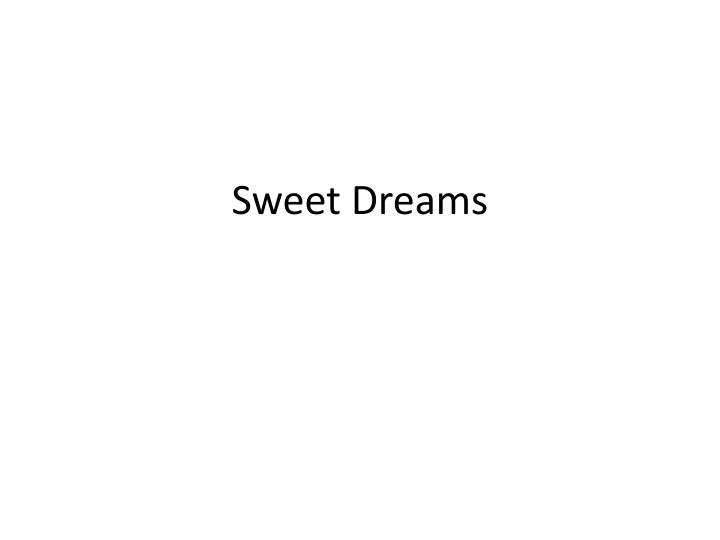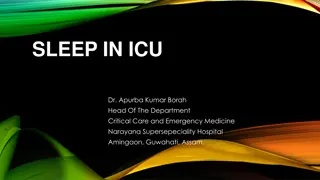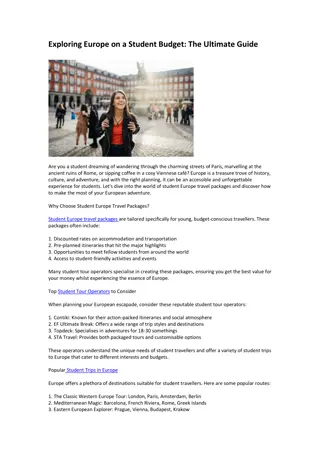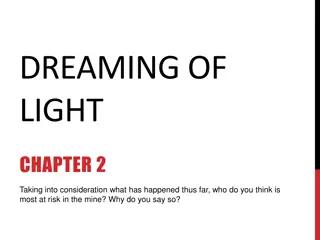
The Fascinating World of Dreams
Delve into the mysteries of dreaming with insights on the function, meaning, and vivid experiences of dreams. Explore the science behind dreaming, its impact on consciousness, and the evolving perspectives on deciphering dream content.
Download Presentation

Please find below an Image/Link to download the presentation.
The content on the website is provided AS IS for your information and personal use only. It may not be sold, licensed, or shared on other websites without obtaining consent from the author. If you encounter any issues during the download, it is possible that the publisher has removed the file from their server.
You are allowed to download the files provided on this website for personal or commercial use, subject to the condition that they are used lawfully. All files are the property of their respective owners.
The content on the website is provided AS IS for your information and personal use only. It may not be sold, licensed, or shared on other websites without obtaining consent from the author.
E N D
Presentation Transcript
The Land of Nod From Breakfast on through all the day At home among my friends I stay, But every night I go abroad Afar into the land of Nod. All by myself I have to go, With none to tell me what to do All alone beside the streams And up the mountain-sides of dreams. The strangest things are there for me, Both things to eat and things to see, And many frightening sights abroad Till morning in the land of Nod. Try as I like to find the way, I never can get back by day, Nor can remember plain and clear The curious music that I hear. Robert Louis Stevenson
Dreaming Dreaming has long fascinated humans. The strongest current scientific hypotheses about dreaming are based on what is known about the underlying differences in biochemistry and brain function among awake, sleeping and dreaming (human) brains. Image: Dream Caused by the Flight of a Bee around a Pomegranate a Second Before Awakening Salvador Dali. A surrealist s vision of dreaming; the woman shown is Dali s wife, Gala.
The Function of Dreams Humans have puzzled over the function of dreams ever since thoughts about them could be recorded. Proposed functions vary from being a window on the soul/psyche to merely a side effect of REM sleep. In this module we will lay out what is known about the neurobiology of dreaming and correlations to subjective reports of dreams. Two prominent hypotheses (among others!) about the function(s) of dreaming will be presented.
The Meaning of Dreams Deciphering the meaning of dreams was one of the bases of Freud s psychoanalytic theories: repressed desires were manifest in dreaming, recall of which could provide a window on someone s psychological state. Much of Freud s theories have been usurped by an examination of neural events that take place primarily during REM sleep, which is correlated with dreaming. Current research emphasizes the function rather than the meaning of dreams. However, deciphering the meaning of dreams continues to be a human endeavor, as a quick internet search shows.
What are Dreams? Dreams are vivid, kaleidoscopic, often complex stories with emotional content, that we experience when we sleep. They simulate reality, seemingly taking place in a spatially and temporally coherent environment. Characters in dreams, the dreamer his/herself and others, are realistic. A sense of knowing exists in the dream. Dreaming is an alternative state of consciousness.
Consensus about Dreams Dream Researchers Consensus: Dreaming evolved separately in warm-blooded vertebrates: mammals and birds. Fragments of episodic memory are source of the tales envisioned. The sleeping hippocampus (see Neurobiology) is responsible for stitching together fragments of dreams. Dream sources (fragments) are related to chronobiological factors. Emotions (the amygdala see Neurobiology) play a part in dreaming. Dreaming probably enhances recall of newly learned material.
Fragments of Dreams: Memories Fragments of dreams arise from both long ago memories (a 1964 Ford Falcon station wagon, a past pet, a site from a long ago vacation) as well as more recent events (the test you failed, the children you watched last week).
Where in the brain do memory fragments come from? The brain part see Neurobiology for details 1) Parts of the cortex present incoherent information, semantic memories, to the hippocampus. 2) Communication between the hippocampus and cortical areas breaks down, resulting in unrealistic context for fragments. 3) Subsequent sleep reinforces communication between the cortex/hippocampus and dispersed memory networks in the cortex. The dream part - results 1) An incoherent mash of images and dreamed experience. 2) Separate episodic memories merge in dream sequence. 3) Weird imagery stitched together into some kind of narrative. 4) A semi-coherent story emerges from memory fragments.
REM and Dreaming: the Brainstem Some parts of the brain become inactive during NREM sleep (see Neurology). During REM sleep the brain is reactivated, resembling an awake state. This shift is due to signals from the brainstem. When this happens, why does the brain dream rather than wake up? Brainstem (pons) signals prior to REM sleep result in inactivation of both motor output and external sensory input. At the same time the brain reads internal activation from the brainstem as sensory signals coming from the outside. These signals results in an internal stimulation of cortical structures: primarily visual and auditory hallucinations: we see in the absence of light. These hallucinations are dreams
How Does the Brainstem Do This? The brainstem contains populations of neurons that release state dependent neurotransmitters. One population of neurons are REM-off cells, which are inactive during REM sleep, but active when awake. A separate population are REM-on cells, active during REM sleep and inactive when awake. Which population is active determines whether the brain is awake or in REM sleep. Aminergic neurotransmitters (serotonin, dopamine, norepinephrine) released by the brainstem suppress REM sleep (REM-off). Other cell populations release acetylcholine that activates REM sleep. REM sleep, and related dreaming, is based on various neurotransmitters sloshing around in our brains.
Which Parts of the Brain? PET and MRI brain scans show that the brain pretty much shuts down during NREM sleep compared with the awake brain (see Neurology). Structures that become activated during dreaming in REM sleep include: the brainstem (primarily the pons) as we ve seen, the amygdala, the seat of emotions, the hippocampus, the source of our personal autobiographies, the parts of the cortex responsible for visual processing and movement.
REM Sleep and Dreams Although correlated, it is important to distinguish between REM sleep and dreams. The former is a brain state, as evidenced by electroencephalograms (EEG) and MRI recordings. Dreams are subjective, requiring a report by the dreamer her/himself. Usually, REM sleep and dreams are linked tightly together. Although brain recordings show similar traces in a suite of patients during REM sleep, these same patients have variable recall of their dreams. Some remember long sequences of their dreams; others can hardly capture any of the dream. Variability in recall emphasizes the subjective nature of dreams and their meaning.
Dreaming and Consciousness J Allan Hobson long pondered the evolution of dreaming. His work led him to elucidate the parallels between consciousness when awake and the consciousness we experience when we the dream. Both include an awareness of perception (seeing, hearing, etc.) and emotion. Neurological correlates, (brain activity previous slides) reflect these similarities. Dreams, with their vivid images and story telling require no external stimuli; the stimuli come from the brain itself. This is indicative of consciousness.
What Conclusions Did Hobson Draw? The close association between awake consciousness and dreaming consciousness, what he terms protoconsciousness, led Hobson to conclude that: Dreaming is both a preparation for and a reaction to awake consciousness. Dreaming reflects a primitive state of consciousness found in warm blooded animals. Because dreams have commonalities among humans, they may assist our highly social species to accomplish shared goals. Dreaming can be viewed as a virtual reality pattern generator to prepare us for new challenges in our environment.
Matthew Walkers Theory of Dreaming Matthew Walker is a researcher who has conducted many sleep studies with human subjects in a lab setting. He has written a popular book on sleep, Why We Sleep (2017). He compares dreaming to a psychotic state, in that when dreaming, we: Hallucinate Are disoriented Delusional Are emotionally labile Suffer amnesia (upon wakening)
The Function of Dreams: Overnight Therapy Based on his own and other other researchers sleep studies, he suggests that dreaming serves as overnight therapy . Dreaming is critical for sorting out and dealing with our emotional lives and mental health. A good night s sleep, including dreaming, helps to resolve daytime stresses. Anecdotally, we all recognize that a poor nights sleep, or several in a row, can leave us in a state of general crabbiness.
Overnight Therapy This theory is based on subjective reports of dreaming, as well as neurological and biochemical information. The hard science part of this theory is based on two phenomena. 1) A dreaming brain is devoid of noradrenaline, which is associated with day time stress. 2) MRI studies show that brain regions associated with emotion, the hippocampus, amygdala and associated parts of the cortex, ramp up activity during dreaming. The theory of overnight therapy suggests that the emotional centers of our brain work through emotional problems without a daytime stressful biochemical environment. The conclusion is that dreaming allows the sleeper to forget the sting of emotional events, yet retain the memory of salient features of these events.
The Function of Dreams: Creativity Well known people have said that an idea (Mendeleev and the period table, Stephen King and lots of weird stuff), images (Salvador Dali), songs (Billy Joel, Paul McCartney) etc. were prompted by a dream. Dreaming is characterized by stitching together fragments of memory that have been consolidated by other aspects of sleep. Does this aspect of dreaming encourage creativity? Waking up subjects from the dreaming phase (indicated by EEG recordings) of sleep showed that they were better at solving scrambled word puzzles than those that were awakened during NREM sleep. Subjects that were awakened during dreaming also make much more creative (even bizarre) connections along ideas and words than those in NREM sleep.
Creative People The luminaries mentioned in the previous slide said that dreaming helped them in the creative process. What, besides dreaming, likely contributed to their new creations?
Discussion Sleep study experiments linking creativity to dreaming are circumscribed in nature (in a lab, shaken awake, electrodes on head). The tasks to be performed are based on scrambled words and letters that subjects are to recall immediately from waking. What are the limitations of these kinds of studies? How do the relate to your experiences of dreaming and any form of creativity?
The Function of Dreams The Superman Ice Cream Problem Even with ongoing sleep studies, the function of dreams remains enigmatic. Perhaps dreams are like the Superman ice cream problem. When asked what flavor the colorful Superman ice cream is, a 6 year old boy threw up his hands and said, Nobody Knows! . Perhaps dreams are like Superman ice cream: colorful, fleeting, enjoyable, messy, multiple flavors (memories), seemingly random, perhaps emotionally satisfying. Nobody really knows.






















